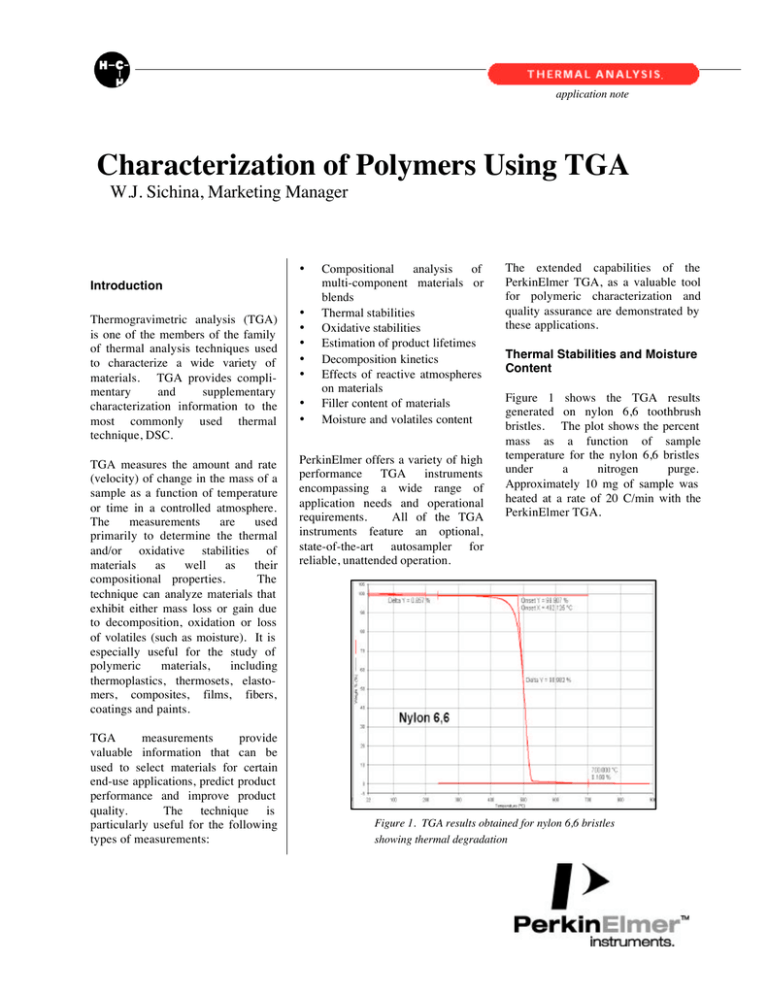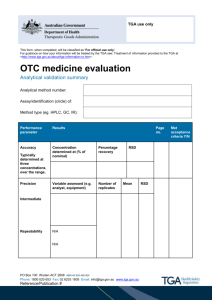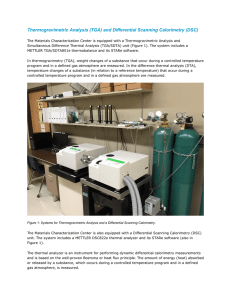Characterization of Polymers Using TGA
advertisement

application note Characterization of Polymers Using TGA W.J. Sichina, Marketing Manager • Introduction Compositional analysis of multi-component materials or blends Thermal stabilities Oxidative stabilities Estimation of product lifetimes Decomposition kinetics Effects of reactive atmospheres on materials Filler content of materials Moisture and volatiles content Thermogravimetric analysis (TGA) is one of the members of the family of thermal analysis techniques used to characterize a wide variety of materials. TGA provides complimentary and supplementary characterization information to the most commonly used thermal technique, DSC. • • • • • TGA measures the amount and rate (velocity) of change in the mass of a sample as a function of temperature or time in a controlled atmosphere. The measurements are used primarily to determine the thermal and/or oxidative stabilities of materials as well as their compositional properties. The technique can analyze materials that exhibit either mass loss or gain due to decomposition, oxidation or loss of volatiles (such as moisture). It is especially useful for the study of polymeric materials, including thermoplastics, thermosets, elastomers, composites, films, fibers, coatings and paints. PerkinElmer offers a variety of high performance TGA instruments encompassing a wide range of application needs and operational requirements. All of the TGA instruments feature an optional, state-of-the-art autosampler for reliable, unattended operation. TGA measurements provide valuable information that can be used to select materials for certain end-use applications, predict product performance and improve product quality. The technique is particularly useful for the following types of measurements: • • The extended capabilities of the PerkinElmer TGA, as a valuable tool for polymeric characterization and quality assurance are demonstrated by these applications. Thermal Stabilities and Moisture Content Figure 1 shows the TGA results generated on nylon 6,6 toothbrush bristles. The plot shows the percent mass as a function of sample temperature for the nylon 6,6 bristles under a nitrogen purge. Approximately 10 mg of sample was heated at a rate of 20 C/min with the PerkinElmer TGA. Figure 1. TGA results obtained for nylon 6,6 bristles showing thermal degradation The TGA results show that the nylon 6,6 polymer undergoes thermal degradation beginning at 482 C and with a total mass loss of 99.0%. There is a small amount of inert residue remaining (0.15%). Nylon polymers absorb a small amount of ambient moisture and TGA can be used to determine this level of water. This may be seen in Figure 2 for the nylon 6,6 sample, which is an enlarged view of the TGA results in the temperature region below the onset of degradation. At about 56 C, the nylon polymer starts to evolve the small amount of moisture, which is found to be 0.86% by TGA. A high performance TGA instrument is required to detect this small level of moisture content. Knowing this moisture content is important as it has a major bearing on the end use properties and processing performance of nylon. The epoxy resin undergoes thermal degradation beginning at 440 C with a mass loss of 57.4%. At 650 C, the purge gas flowing over the sample was automatically switched to oxygen and the carbon residue was burned off at 655 C with a mass loss of 10.5%. [The PerkinElmer TGA instruments all feature the option of an automated gas flow and gas switching accessory for ease of conducting TGA thermo-oxidative experiments]. The material remaining behind after exposing the sample to oxygen is the inert glass filler, which the TGA shows comprises 31.8% of the mass of the epoxy resin. Filler Content in Polymers Figure 2. TGA results showing water wright loss for nylon 6,6 One major application of TGA is the assessment of the filler content in polymers and composites. The level of fillers can have a significant impact on the end use properties (thermal expansion, stiffness, damping) of the final product. This is particularly important for electronics applications where the level of filler affects the coefficient of thermal expansion (CTE) as measured using the PerkinElmer TMA. It is important for the components in a printed circuit board to have very similar expansivities or else built-in stresses over time can occur. Displayed in Figure 3 are the TGA results generated on a glass filled epoxy resin used for electronic applications. Figure 3. TGA results for epoxy-glass powder 2 Characterization of the Differences in Polymers A high performance TGA, such as the ones available from PerkinElmer, allow for the detection of subtle, but potentially important, differences between polymers. Shown in Figure 4 are the TGA results obtained on two different high density polyethylene (HDPE) containers. One is an opaque soap container while the other is a semitransparent water bottle. The soap bottle HDPE resin has a slightly, but significantly, higher level of filler (2.1% versus 0.65%). This information is important for the production of the containers. Compositional Analysis Multi-component Polymers toughness properties to the ABS blend. ABS is typically used for housings for personal computers and other electronic equipment and the material’s impact resistance is important for its long term durability. The weight loss transition of the butadiene rubber component occurs extremely close to the decomposition of the SAN copolymer. Standard TGA cannot separate out the two events. However, Auto Stepwise TGA does provide the ability to resolve the two weight loss events and makes the quantitative compositional analysis of the ABS possible. This may be seen in the Auto Stepwise TGA results obtained on ABS displayed in Figure 5. The butadiene, rubber component is nicely separated from the SAN decomposition and this provides excellent characterization information. of One of the most important applications of TGA is the assessment of the compositional analysis of polymeric blends. The compositional characterization information can be enhanced through the use of Auto Stepwise TGA, where the TGA instrument automatically heats the sample and then holds it under isothermal conditions when the instrument detects a significant weight loss. This provides the highest possible separation of overlapping decomposition events and provides for the most accurate compositional analysis of polymers. An example of the ability of the Auto Stepwise approach to provide useful compositional information is in the characterization of ABS. This is a polymer alloy comprised of a SAN matrix (styrene acrylonitrile copolymer) with butadiene. The butadiene is a rubbery component and provides the desired impact and Figure 4. TGA degradation for two different HDPE bottles Figure 5. Auto Stepwise TGA results for ABS showing separation of SAN and butadiene components 3 Another example of the ability of the Auto Stepwise approach to provide outstanding separation of overlapping weight loss events is for tire elastomers. These elastomers consist of a blend of polymer, oil extender, carbon black and fillers. It is difficult to separate out the oil from the polymer using standard TGA since the two events severely overlap. However, with the Auto Stepwise approach, all of the components in a tire elastomer can be clearly identified as is shown in Figure 6. This information is valuable for the production of an automotive tire with the desired end use and long term properties. Measurement of Low Level of Volatiles Many polymer applications are sensitive to occurrence of low level volatilization. On a large production basis, even a small level of volatiles (e.g., less than 1%) can have a major impact on the processing of the polymer. It is known that low levels of volatiles can affect the injection molding or blow molding processing of polymers. Shown in Figure 7 is the low level of volatilization obtained for a single pellet of PET resin. This measurement was performed holding the sample under gentle isothermal conditions at 130 C. The mass loss observed at 10 hours was 0.219% for the PET pellet. This is an important aspect for PET resins used to make beverage containers as low levels of soluble volatile components can affect the taste of the beverage. The high performance TGA instruments from PerkinElmer provide the high degree of sensitivity and stability to make these long term measurements possible. Figure 6. Auto Stepwise TGA compositional results for tire elastomer showing separation of oil, polymer, carbon black and filler Low Level of Volatiles from PET Resin at 130 C Single Pellet Figure 7. Low level emission of volatiles from single PET chip under gentle isothermal conditions at 130 C 4 TGA Decomposition Kinetics for Lifetime Predictions TGA decomposition information can be used to predict the useful product lifetimes of some polymeric materials, such as the coatings for electrical or telecommunication cables. The sample is heated at three or more different heating rates. The use of the different heating changes the time scale of the decomposition event. The faster the applied heating rate, the higher the given decomposition temperature becomes. This approach establishes a link between time and temperature for the polymer decomposition and this information can be used to model the decomposition kinetics. Shown in Figure 8 are the TGA results generated on a sample of polyethylene at heating rates ranging from 1 to 40 C/min. As the heating rate is increased, the onset of decomposition is moved to higher temperatures. This data can then be analyzed using the PerkinElmer TGA Decomposition Kinetics Software. The kinetics analysis provided by the software provides valuable predictive information on polymeric materials, including lifetime estimations. Displayed in Figure 9 are the isoconversion curves, which presents the time to achieve a particular level of conversion as a function of temperature. These are particularly useful for product lifetime assessments. If the desired level of critical conversion is known, then the time to achieve this critical level at a particular operating or end use temperature can be predicted. Figure 8. Effect of heating heat on thermal decomposition of polyethylene Figure 9. Isoconversion curves for polyethylene thermal degradation based on kinetics modeling 5 PETech-78



